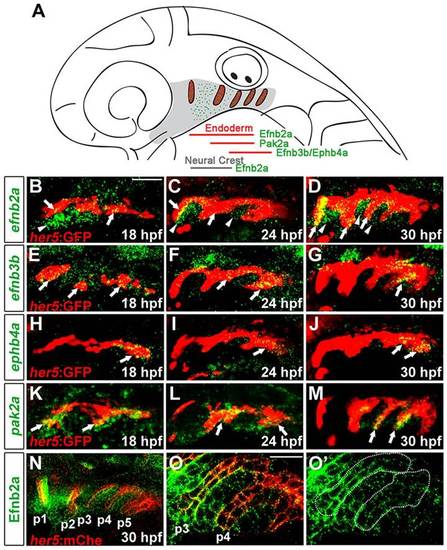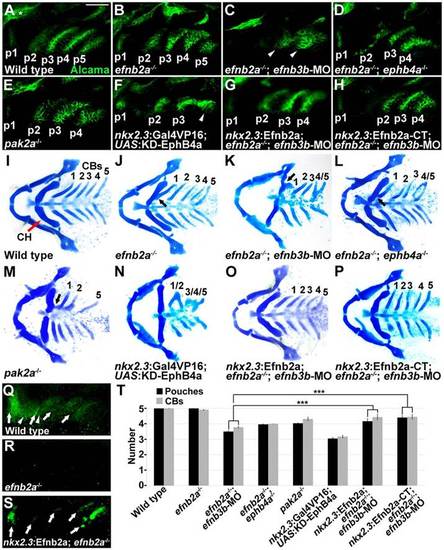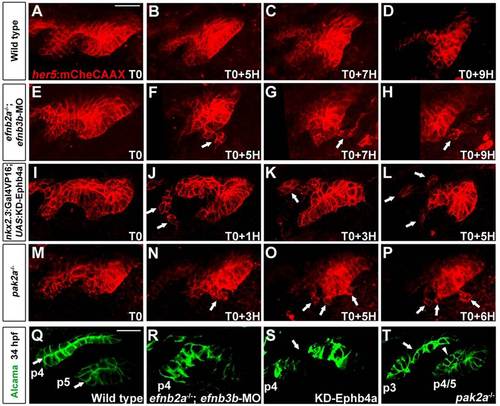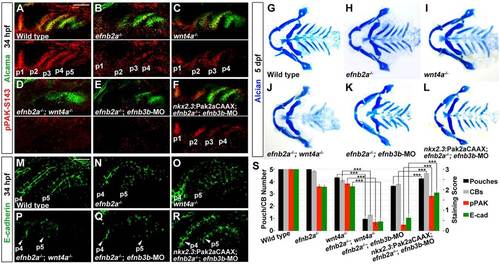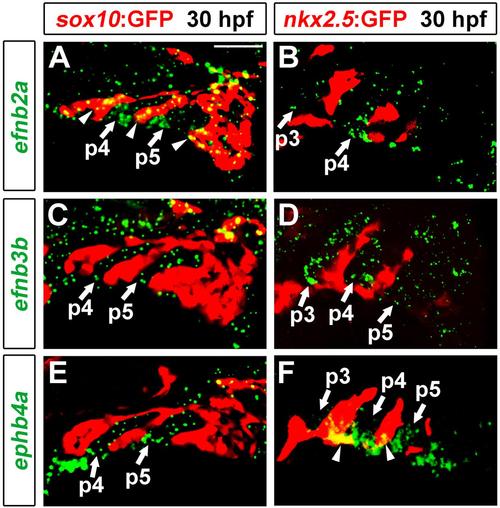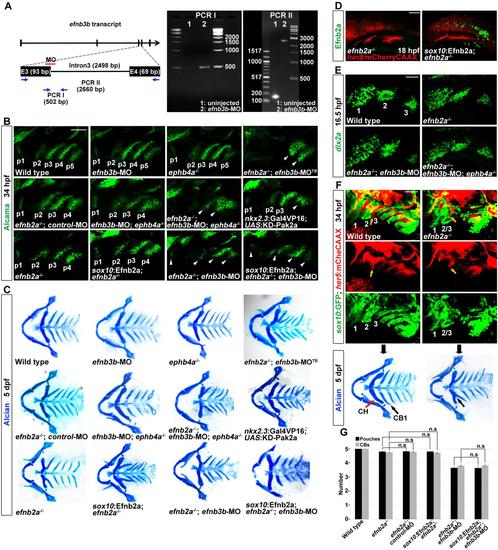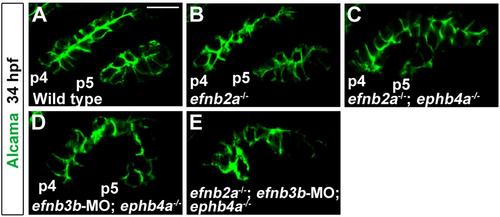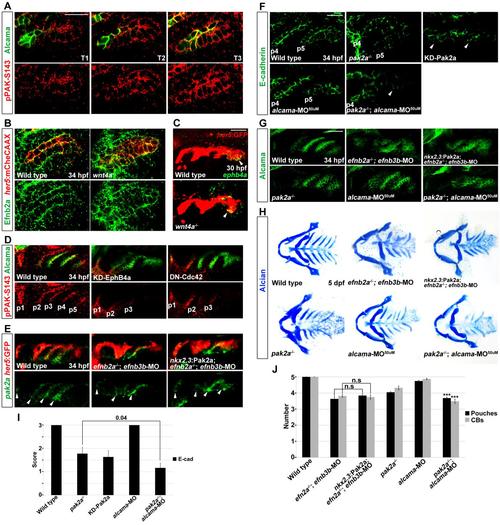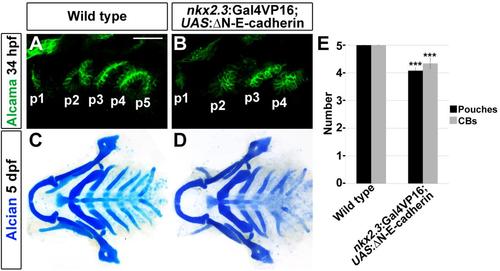- Title
-
Eph-Pak2a signaling regulates branching of the pharyngeal endoderm by inhibiting late-stage epithelial dynamics
- Authors
- Choe, C.P., Crump, J.G.
- Source
- Full text @ Development
|
Eph-ephrin and pak2a expression in pouches. (A) Schematic of pouches and expression of efnb2a, efnb3b, ephb4a and pak2a within the 30hpf zebrafish head. (B-M) Fluorescent in situ hybridization (green) shows a time-course of expression for efnb2a, efnb3b, ephb4a and pak2a relative to her5:GFP+ endodermal pouches (labeled red by GFP immunohistochemistry). Arrows show expression in pouch endoderm and arrowheads show expression in neural-crest-derived cells. Scale bar: 40µm. (N-O′) Anti-Efnb2a staining (green) relative to her5:mCherryCAAX+ endoderm (red) shows increased expression in more mature anterior pouches (e.g. p3) relative to less mature posterior ones (p4 and p5), as well as in neural-crest-derived cells. Dotted lines in O′ denote pouch expression. Scale bar: 20µm. EXPRESSION / LABELING:
|
|
Eph-ephrin and pak2a requirements in craniofacial development. (A-H) Alcama immunohistochemistry (green) at 34hpf labels five pouches (p1-p5) in wild types, as well as neuronal ganglia (*), with varying degrees of pouch defects in mutants and transgenic embryos. Scale bar: 40µm. (I-P) Ventral views of facial cartilages. In wild types, a bilateral set of five CBs (5) form posterior to the ceratohyal (CH). Fusions, reductions and losses of CBs are observed in mutants and transgenics, as well as fusions of CH with CB1 (arrows). (Q-S) Immunohistochemistry at 30hpf shows Efnb2a protein (green) in pouches (arrows) and neural-crest-derived mesenchyme (arrowheads). Efnb2a protein is lost in efnb2a mutants and selectively restored to pouch endoderm by the nkx2.3:Efnb2a transgene. (T) Quantification of pouch and CB defects. Data represent mean±s.e.m. ***P<0.001. |
|
Pouch disintegration in the absence of EphB-Pak2a signaling. (A-P) Confocal projections from time-lapse recordings show development of her5:mCherryCAAX+ pouches p4-p6 (red). In embryos with reduced Efnb2a/b3b, endoderm-specific expression of KD-Ephb4a or mutant for pak2a, cells break off from the epithelium (arrows) as pouches migrate outwards. Movies start at 25hpf (T0). (Q-T) Confocal sections show pouches labeled by Alcama immunohistochemistry at 34hpf. Whereas wild-type pouch epithelial cells form bilayers with a straight line of apical membranes (arrows in Q), apical membranes are variably disorganized in embryos with reduced Efnb2a/b3b, endoderm-specific expression of KD-Ephb4a or mutant for pak2a. Note dissociated pouch epithelial cells (arrow) in nkx2.3:Gal4VP16; UAS:KD-Ephb4a embryos (S) and regions of monolayered (arrow) and multilayered (arrowhead) epithelia in pak2a mutant pouches (T). Scale bars: 20µm. |
|
Requirements for Eph-ephrin and Wnt signaling in PAK activation and E-cadherin levels. (A-F) Immunohistochemistry shows Alcama (green) and the activated form of PAK (pPAK-S143, red) at 34hpf. In wild types, pPAK-S143 is higher in anterior pouches (p1-p3) compared with less mature posterior pouches (p4 and in particular p5). Compound efnb2a; wnt4a mutants produce fewer pouches and have further reduced pPAK-S143 staining than single mutants alone. In EphrinB-deficient embryos, forced expression of membrane-targeted Pak2a (nkx2.3:Pak2aCAAX) rescues both pouches and PAK autophosphorylation. Scale bar: 40µm. (G-L) Ventral views of facial cartilage at 5dpf show losses of CBs and CH-CB1 fusions in mutants and rescue of these defects in EphrinB-deficient embryos by nkx2.3:Pak2aCAAX. (M-R) Immunohistochemistry shows E-cadherin protein (green) within pouches p4 and p5. In wild types, E-cadherin localizes to cell-cell contacts along apicolateral membranes. Compound efnb2a; wnt4a mutants have further reduced E-cadherin staining than single mutants alone, and nkx2.3:Pak2aCAAX rescues E-cadherin levels in EphrinB-deficient embryos. Scale bar: 20µm. (S) Quantification of pouch and CB defects, and scoring of reduced pPAK and E-cadherin staining. Data represent mean±s.e.m. ***P<0.001. |
|
Eph-ephrin gene expression within the 30-hpf zebrafish head. Fluorescent in situ hybridization (green) shows expression of efnb2a (A,B), efnb3b (C,D) and ephb4a (E,F) relative to sox10:GFP+ neural crest-derived mesenchyme (red in A,C,E) and nkx2.5:GFP+ mesoderm (red in B,D,F). In addition to staining in pouches p3, p4 and p5, we also observed expression of efnb2a in neural crest-derived cells (arrowheads in A) and ephb4a expression in ventral arch mesoderm (arrowheads in F) adjacent to more mature pouches. Scale bar: 20 µm. |
|
EphB signaling in pouch, CB cartilage and neural crest development. (A) An MO was designed against the exon 3 (E3)-intron 3 splice junction of efnb3b. In uninjected control embryos, normal splicing of exons 3/4 resulted in excision of intron 3 (2498 bp) and loss of PCR amplification of 24-hpf embryonic cDNA by the designated primers (arrows of PCR I) and amplification of a 162 bp band spanning exons 3/4 (arrows of PCR II). By contrast, 24-hpf embryos injected with 1 nL of 300 µM efnb3b MO at the one-cell stage resulted in amplification of a 502 bp band (PCR I) and a 2660 bp band (PCR II), and loss of the 162 bp band spanning exons 3/4 (PCR II), due to a failure to splice out intron 3. (B) Alcama immunohistochemistry reveals normal pouches in efnb3b- MO and ephb4a-/- single mutants, and disrupted pouches in efnb3b-MO; ephb4a-/- and efnb2a-/-; efnb3b-MO; ephb4a-/- compound mutants. Whereas injection of a translationblocking efnb3b morpholino (efnb3b-MOTB) enhanced the defects of efnb2a mutant pouches, injection of a control morpholino antisense to the splice-blocking morpholino failed to enhance. Forced expression of a dominant-negative KD-Pak2a transgene in the nkx2.3+ endoderm (nkx2.3:Gal4VP16; UAS:KD-Pak2a) also resulted in reduced numbers of dysmorphic pouches. Compared with non-transgenic efnb2a-/- or efnb2a-/-; efnb3b-MO siblings, the sox10:Efnb2a transgene did not rescue pouches in EphrinB-deficient mutants. Arrowheads denote malformed pouches. Scale bar: 40 µm. (C) Alcian Blue staining of cartilage reveals no CB defects in efnb3b-MO and ephb4a-/- single mutants, and lost and/or fused CBs in efnb3b-MO; ephb4a-/- and efnb2a-/-; efnb3b-MO; ephb4a-/- compound mutants, as well as in embryos with endoderm-specific Pak2a disruption. Injection of a translation-blocking but not a control efnb3b-MO into efnb2a mutants enhanced CB defects of efnb2a mutants. sox10:Efnb2a transgene in either efnb2a single mutants or efnb2a-/-; efnb3b-MO compound animals failed to rescue losses of CBs and fusions of CH and CB1. (D) Immunohistochemistry at 18 hpf shows that Efnb2a protein is lost in efnb2a mutants and restored to migratory neural crest mesenchyme by the sox10:Efnb2a transgene. her5:mCherryCAAX labels pre-pouch endoderm where Efnb2a expression is not restored. Confocal projections are shown. Scale bar: 40 µm. (E) Fluorescent in situ hybridization for dlx2a (green) at 16.5 hpf shows no intermingling of neural crest cells between the three migrating streams (numbered) in embryos with losses of EphrinB ligands and EphB receptors. Scale bar: 40 µm. (F) Development of pharyngeal arches, pouches and cartilages in individual efnb2a mutants and wild-type siblings. In wild types at 34 hpf, labeling of neural crest-derived cells by sox10:GFP (green) shows six arches, and labeling by her5:mCherryCAAX (red) shows five pouches. Note that arches 2 and 3 are fully separated by the second pouch (yellow arrow), and by 5 dpf, Alcian Blue staining reveals that the CH and CB1 cartilages are well separated. In the efnb2a-/- example, the second pouch does not extend as far ventrally (yellow arrow) and arches 2 and 3 appear fused ventrally. In this same animal at 5 dpf, CH and CB1 cartilages are also fused ventrally (arrow). Scale bar: 40 µm. (G) Quantification of pouch and CB defects. Data represent mean±s.e.m. n.s., not significant. |
|
Requirements of Eph-ephrin signaling in pouch morphology. (A-E) High magnification confocal sections show pouches p4 and p5 labeled by Alcama immunohistochemistry at 34 hpf. In contrast to wild-type pouch epithelial cells that form bilayers with straight lines of apical membranes, pouch epithelial cells from Eph-ephrin deficient embryos appear disorganized. |
|
Parallel requirements for Pak2a and Alcama in pouch and CB cartilage development. (A) Double immunohistochemistry of pPAK-S143 (red) with Alcama (green) during maturation of the fifth pouch in wild types. As pouch development proceeds, Alcama becomes progressively enriched at sites of cell-cell contact while pPAK-S143 staining increases. Scale bar: 20 µm. (B) Immunohistochemistry shows that Efnb2a protein (green) is still present in her5:mCherryCAAX+ pouches (red cell membranes) in wnt4a-/- mutants and wild-type siblings. Efnb2a protein is also unaffected in surrounding neural-crest-derived cells (not labeled red) of wnt4a-/- mutants. (C) Fluorescent in situ hybridization shows ephb4a expression (green, arrowheads) in nascent her5:GFP+ pouches (labeled red by anti-GFP immunohistochemistry) in wnt4a mutants and wild-type siblings. Scale bar: 40 µm. (D) Double immunohistochemistry shows that pPAK-S143 staining (red) is reduced in the posterior pouches labeled by Alcama (green) of embryos expressing kinase-dead Ephb4a (nkx2.3:Gal4VP16; UAS:KD-Ephb4a) or dominantnegative Cdc42 (nkx2.3:Gal4VP16; UAS:DN-Cdc42) specifically in the endoderm. (E) Fluorescent in situ hybridization shows pak2a expression (green, arrowheads) in the her5:GFP+ pouches (labeled red by anti-GFP immunohistochemistry) in wild types, efnb2a-/-; efnb3b-MO embryos and nkx2.3:Pak2a; efnb2a-/-; efnb3b-MO embryos. (F) Immunohistochemistry shows E-cadherin protein (green) within pouches p4 and p5. In pak2a mutants or embryos expressing dominant-negative Pak2a specifically in the endoderm (nkx2.3:Gal4VP16; UAS:KD-Pak2a), E-cadherin staining is mildly reduced. Whereas injection of a low dose of alcama-MO (50 µM) into wild types causes no defects in E-cadherin localization, injection into pak2a mutants causes a greater reduction of Ecadherin staining (arrowhead) than seen in pak2a mutants alone. Scale bar: 20 µm. (G) Alcama immunohistochemistry reveals more severe defects in pouches in pak2a-/-; alcama-MO (50 µM) compound animals than in single pak2a mutants or alcama-MO animals. In addition, the nkx2.3:Pak2a transgene fails to rescue the pouch defects of efnb2a-/-; efnb3b-MO animals. Scale bar: 40 µm. (H) Alcian Blue staining reveals more severe losses of CB cartilages in pak2a-/-; alcama-MO (50 µM) compound animals compared with single pak2a mutants or alcama-MO animals. In addition, the nkx2.3:Pak2a transgene fails to rescue the CB cartilage defects of efnb2a-/-; efnb3b-MO animals. (I) Quantification of E-cadherin staining reduction. Data represent mean±s.e.m. P-values are shown. (J) Quantification of pouch and CB defects. Data represent mean±s.e.m. *** shows P<0.001 compared with pak2a mutants or alcama-MO animals. n.s., not significant. |
|
Requirement of E-cadherin in pouch morphogenesis. (A-D) Forced expression of a dominant-negative N-terminally-truncated E-cadherin transgene in pouch endoderm (nkx2.3:Gal4VP16; UAS:&916;N-E-cadherin) resulted in reduced numbers of dysmorphic pouches (B), as well as fusions of CB cartilages (D). Scale bar: 40 Δm. (E) Quantification of pouch and CB defects. Data represent mean±s.e.m. *** shows P<0.001 relative to non-transgenic ‘wild-type’ siblings. Development |

